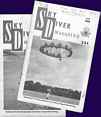|
In 1956, a 29 year old French skydiver name Jacques Andre Istel came to America. He brought with him a French opening device called a "sleeve" that would create a new sport in America, sport parachuting. The sport wasn't really new. As early as the late 40's, many ex-paratroopers were doing crude skydives using surplus Army Air Force and Army rigs, mostly Army T-7's (with twill 28' canopies) and T-7a reserves (24' twill canopies) and then later some USAF B-4 harness and containers with C-8 or C-9 28' twill canopies. Even the odd seatpack was put to good use. A good example of a club from that era, which formed in 1948 and is still in continuous operation in Canada is at www.skydiving.com/main.html The sleeve suddenly made the opening shock bearable and reduced it from very very painful to very uncomfortable by todays' standards. The French had adopted the arch & spread exit and falling position used by French and German paratroopers in WW2 to develop the sport and later developed the position we now call the "French Frog", which we still use today. The sleeve suddenly made the sport viable for the average person in good health.
Along with the sleeve and the French techniques, Istel also brought with him a great dream. He would set up, not just another club, but an actual commercial company, fully equipped to train skydivers in a modern (for the 1950's at least) and profitable manner. Istel set up his first corporation, Jacques Istel & Co. in 1956 and in December of 1956 he approached Lew Sanborn (D-1) to join the corporation. The company was incorporated not only to train jumpers but also to design and sell a line of parachute equipment solely for sport jumping. Lew moved to Bedford Village in January 1957 where Istel and his wife were living. The company received its first big break in that same year when Jacques talked the US Army into contracting the company to become the first HALO instructors to the US Army. Next, Istel and Sanborn contracted the help of Wolfgang Liesche (who only recently died) and the trio started the first HALO school at Ft. Bragg, NC.. The Army handed them their first 6 trainees and training stated at the 77th Special Forces Facility at Ft. Bragg in November. The course lasted till the end of the year and the trainees were taught to make 30 second delays and land within 50 yeards of a target. Starting with the next class, the training moved onto jumps from 35-40,000 feet. When the Army contract was finished
and the Army could function on its' own, Sanborn and Istel disolved JI&Co
and started a new company in 1958 called Parachutes Incorporated.
They moved PI to "Batch" Pond's "Good Hill Farm" in XXX Connecuit and established
the first PI DZ. They used the Pond Cessna 170 with a Fulton Conversion
(180hp Lycoming with a variable pitch propeller which put it in the Cessna
180 class) (Note: Batch Pond's son, Nate still flys the "Fulton
170" with his brother Lawrence who current runs Good Hill Farm.).
The company prospered and could soon afford it's own aircraft and bought
a used 1956 Cessna 182.
|

 The
efforts of Istel and other pioneers helped the sport grow so fast that
Lyle Cameron (of Southern California) put out the first addition of "SKY
DIVER" magazine in 1958. It was a glossy, Black and White, 5½x8½
inches, 32 page magazine which sold for 25 cents!
The
efforts of Istel and other pioneers helped the sport grow so fast that
Lyle Cameron (of Southern California) put out the first addition of "SKY
DIVER" magazine in 1958. It was a glossy, Black and White, 5½x8½
inches, 32 page magazine which sold for 25 cents!


